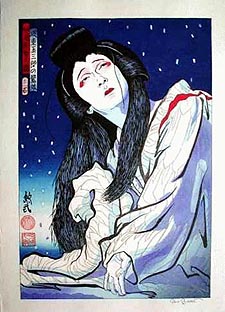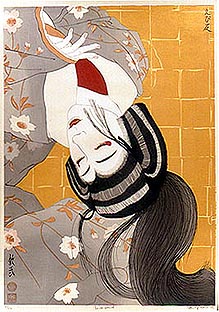"NOS JARDINS DE BINNIE"
SECRETARIA DE ESTADO DA CULTURA Inspirado nas obras: Kabuki Woodblock Prints Series, Paintings of the Nô (Noh) Theatre Series e The Traditional Japanese Tattoo Series(Yakuza Prints) do Artista Plástico PAUL BINNIE
Creation, direction and production:
Criação, direção e produção:
JOAO BUTOH
Interpretação: Ogawa Butoh Center
GOVERNO DO ESTADO DE SÃO PAULO
“PROGRAMA DE INCENTIVO A DANÇA PAULISTA - 2008”
PATROCINADORA: SABESP
Ministério da Cultura - Lei Rouanet



“NOS JARDINS DE BINNIE”
Um passeio pelas obras de Binnie, ponto de partida para falarmos deste corpo estrangeiro. A busca pelo domínio de um movimento que não é o nosso. Onde a beleza e a dramaticidade caminham juntas para a impressão final da obra. O processo de abrir o sulco na madeira – descobrir o movimento no corpo, a busca pelas cores perfeitas e o desenho estético que será impresso no papel – na obra coreográfica.
Na gravura, as primeiras cópias são as mais valiosas. A “P. A.” (prova de artista) a mais valiosa, depois a cada impressão, a matriz de madeira vai se danificando, os traços mais delicados já não são tão perfeitos. E a quantidade de cópias impressas de cada matriz, indica o quanto ela vale no mercado de obras de arte.
E o corpo? Seria possível traduzir isso em movimento. O definhamento do corpo estaria relacionado a quantidade de cópias realizadas sobre esta matriz. O que acontece com esse corpo estrangeiro que foi moldado para realizar estas cópias?
Agregamos a este pensamento a essência do butoh, unindo as referências de dualidades nos corpos destes bailarinos/matrizes, para trafegar na obra deste grande gravurista britânico Paul Binnie.
As Gravuras do Kabuki
Paul Binnie viveu no Japão de 1993 a 1998 e tornou-se um estudioso do Kabuki e também do Nô. As gravuras de Kabuki têm uma longa e variada história, as primeiras cópias foram produzidas comercialmente no fim do Século XVII no Japão e tendo uma valorização bastante significativa no Século XX.
Binnie é o único artista estrangeiro que usou o ator na sua essência em suas gravuras, e combina as habilidades do desenhista, do escultor e do impressor, que no passado eram trabalhos de especialistas nesta técnica de pintura.
As Pinturas do Teatro Nô (Noh)
As origens do teatro Nô são antigas, máscaras, formas dramáticas originaria da China. A máscara tem um elemento central no Nô por volta de seiscentos anos. O ator principal usa uma máscara se estiver representando uma mulher, um espírito, um deus, um menino novo, um homem velho ou qualquer caráter à exceção de um homem adulto. Atores subsidiários e crianças (chamados "kokata") não usam máscaras, mas todos os atores no palco se vestem com seda e brocados de refinamento máximo. A Performance é uma combinação da canção, melodia, discurso e dança. Os temas dos espetáculos são mitologias antigas e as lendas da China e do Japão, geralmente com enredo razoavelmente simples, mas complexo com uma linguagem poética e literária alusiva a estes temas.
Sobre o artista Paul Binnie
Paul Binnie nasceu em 1967, em Alloa entre Glasgow e Edimburgo.
Quando tinha 18 anos, em 1985, foi estudar na Universidade de Edimburgo e na Faculdade de Artes de Edimburgo. E 5 anos mais tarde, em 1990, Paul fez seu Mestrado em Artes (hons.) em “Fine Art”. O Curso era uma combinação de historia da arte na universidade, especialização em arte asiática, japonismo e no ukiyo-e e da pintura, do desenho e (ocidental) da gravura na Faculdade de Arte.
De 1986 a 1989 o artista passou os verões em Paris e em outras regiões da França - em parte trabalhando para ganhar dinheiro ou pintando. Foi durante este período que comprou seu primeiro conjunto para ukiyo-e em Paris em 1986/87. O interesse de Paul no ukiyo-e foi amor a primeira vista e o impulsionou a estudá-lo muito intensamente.




Obras de Paul Binnie

JOAO BUTOH
Interpretation: Ogawa Butoh Center
SECRETARIA DE ESTADO DA CULTURA
GOVERNO DO ESTADO DE SÃO PAULO
“PROGRAMA DE INCENTIVO A DANÇA PAULISTA - 2008”
PATROCINADORA: SABESP
Ministério da Cultura - Lei Rouanet



“IN THE BINNIE’S GARDENS”
The performance is inspired in the Paul Binnie’s works. Paintings of the Nõ (Noh) Theatre, Kabuki Woodblock Prints and the traditional Japanese tattoo (Yakuza tatoos).
Kabuki Woodblock Prints
Paul Binnie lived in Japan from early 1993 to late 1998 and became closely involved in the study of Kabuki and also Nõ. Kabuki prints have a long and varied history, being amongst the first commercially produced prints made at the end of the seventeenth century in Japan and having an unbroken linage well into the twentieth century. Binnie is the only foreign artist to use the actor so consistently in his woodblocks, and combines the skills of designer, block-cutter and printer, all of which in the past were specialist jobs performed by individuals.
Paintings of the Nõ (Noh) Theatre
The origins of the Nõ Theatre are ancient, masked, dramatic forms originating in China. The mask has been a central element of Nõ for around six hundred years. The main actor wears a mask if he is representing a woman, a spirit, a God, a young boy, an old man or any character other than a mature adult male. Subsidiary players and children (called "kokata") do not wear masks, but all actors on the stage are dressed in silks and brocades of the utmost refinement. The performance itself is a combination of song, chant, speech and dance. The subjects of the plays are ancient mythologies and legends of China and Japan, generally fairly simple in plot but complex in the layering of poetic language and literary allusion.
About Paul Binnie
Paul Binnie was born in Alloa in Scotland. Alloa is a small town on the River Forth in the very center of the Scottish lowlands, halfway between Glasgow and Edinburgh. From an early age on Paul knew what he wanted to become - an artist. From the age of 12 he took extra classes with a local artist.
When he was 18 years old, in 1985, he went to study a joint degree at Edinburgh University and Edinburgh College of Art. And 5 years later, in 1990, Paul made his MA (hons) in Fine Art. The degree was a combination of art history at the University - specializing in Asian art, japonism and ukiyo-e - and of painting, drawing and (Western) printmaking at the College of Art.
From 1986 to 1989 the young artist spent the summers in Paris and other regions of France - partly working to earn money or painting. It was during this time that he bought his first group of ukiyo-e in Paris in 1986/87. Paul's interest in ukiyo-e was firmly established and he decided to study it more intensively.
